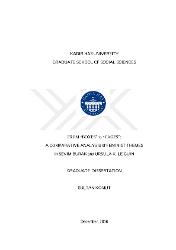| dc.contributor.advisor | O'neil, Mary Lou | |
| dc.contributor.author | Komut, Sultan | |
| dc.date.accessioned | 2023-10-17T20:46:19Z | |
| dc.date.available | 2023-10-17T20:46:19Z | |
| dc.date.issued | 2016 | |
| dc.identifier.uri | https://tez.yok.gov.tr/UlusalTezMerkezi/TezGoster?key=DPTyuy3wRPq_qvCPSqUB68SkB6YPQV_aZphcJhJtyV6Iy6AHsXPN5YRaFGwU-pMp | |
| dc.identifier.uri | https://hdl.handle.net/20.500.12469/4473 | |
| dc.description.abstract | Karşılaştırmalı bir edebiyat çalışması olarak bu tez Sevim Burak ve Ursula K. Le Guin'in eserlerindeki feminist temalardaki benzerlikleri ortaya çıkarmayı amaçlar. İki yazarın bazı temaları eserlerine dâhil edip, bazılarını dışarıda bırakmak suretiyle temaları ele alış şekillerindeki farklılıkları işaret eder. Bu bakımdan tez, dahil etmenin yanı sıra, dışarıda bırakmayı da konu edinir. Sevim Burak bu temaları yaşadığımıza benzeyen, sıradan dünyalarda alışagelmemiş bir yazı stiliyle dile getirirken, Ursula K. Le Guin geleneksel bir yazı stiliyle sıra dışı dünyalar ve karakterler yaratır. Eserlerini yaratma süreçlerinde her iki yazar da phallogosentrik dili yok etmeyi amaçlar, bu nedenle her iki yazar da feminist yazın geleneğinin temsilcileri olarak düşünülebilir. Özellikle Sevim Burak Ecriture Feminine geleneğinin bir temsilcisidir. Burak ve Le Guin'in eserlerinde temel olarak incelenen; ötekilik, baskı ve içselleştirilmiş itaatkarlık temaları bağlam, karakter ve söylem analizleri yoluyla incelenmiştir. Kadınların patriyarkal, 'eril' bakış açısı ile değerlendirildiği; hem zihinde hem de mekanda 'öteki' olarak kabul edildiği ileri sürülmüştür. Bu bağlamda zihindeki ötekilik kadınların mental olarak değersizleştirilmesi olarak ifade edilirken, mekandaki ötekilik daha elle tutulur, somut sonuçlar olarak sunulmuştur. Ötekilik başlığında değersizleştirilme yoluyla 'kadınlaştırılmış' karakterlere de özel bir parantez açılmıştır. Bununla birlikte, kadınlar üzerindeki baskı iki ana başlıkta incelenmiştir: Bireysel baskı formları ve kolektif baskı formları. Eserlerde, anne baba baskısı ve evliliğin getirdiği baskı bireysel baskı formları olarak ele alınırken, kolektif baskı formları din, patriyarkal toplum ve metalaştırmaya odaklanır. Çeşitli yollarla baskılanan kadınların sınırlı seçenekleri olduğu ifade edilmiştir: İtaatkârlığı içselleştirmek ya da baskıyı sorgulamak hatta onunla mücadele etmek. İtaatkârlığı içselleştirenlerin zamanla ya bağımlı ya da imaj güdümlü karakterler oldukları ifade edilmiştir. Baskıya karşı mücadelelerinde çoğu kadın kendileri ile baskı şekilleri arasındaki gerilimde kaybolmuş ve çoğunlukla bu mücadele karakterlerin ölümleriyle sonuçlanmıştır. Anahtar Kelimeler: Sevim Burak, Ursula K. Le Guin, feminist eleştiri, kurgu, kadın temsilleri, baskı türleri, din, aile, evlilik, metalaştırma, ötekilik, içselleştirilmiş itiatkârlık | en_US |
| dc.description.abstract | As a comparative literature study, this study aims to analyze the works of Sevim Burak and Ursula K. Le Guin in order to unearth the similar feminist themes they explore in their works indicating that two authors differ in exploring them; including some and not the others. In that matter, the study tries to analyze the exclusions as well as the inclusions. While Sevim Burak explores in these feminist themes in common, usual worlds that resemble ours with unconventional writing style, Ursula K. Le Guin creates unusual worlds and characters with traditional writing style. While creating their works they both aim to destroy phallogocentric language in different ways, which makes them become the representatives of Feminist Writing. Sevim Burak, in particular, can be considered a representative of Ecriture Feminine. In the selected works of Burak and Le Guin three principal themes are analyzed by the help of context, character and discourse analyses; otherness, oppression and internalized submission. It is argued that women are looked at through a patriarchal 'male' gaze; considered to be the other both in mind and in space. Otherness in mind is explored as mental devaluation and otherness is space is explored as the tangible results of being considered as the other. Some characters who are 'womanized' through the ways of devaluing are also focused as a special parenthesize to otherness. Oppression on women, on the other hand, is analyzed under two categories; individual forms of oppression and collective forms of oppression. In the selected works, oppression resulting from family which focuses on parental pressure and marriage are analyzed as a form of individual oppression. Yet, oppression resulting from religion, patriarchal society and commodification of women are explored as the collective forms of oppression. It is also argued that those who are oppressed in one way or another have limited options; internalizing submission or questioning, further, fighting with the oppression. The ones who internalize submission become either dependent or image driven women. In their struggles with oppression, most women get lost in the tension between them and the forms of oppression, which most generally ends with the deaths of these characters. Key words: Sevim Burak, Ursula K. Le Guin, feminist criticism, fiction, representations of women, forms of oppression, religion, family, marriage, commodification, otherness,internalized submission | en_US |
| dc.language.iso | eng | en_US |
| dc.publisher | Kadir Has Üniversitesi | en_US |
| dc.rights | info:eu-repo/semantics/openAccess | en_US |
| dc.subject | Amerikan Kültürü ve Edebiyatı | en_US |
| dc.subject | American Culture and Literature ; Karşılaştırmalı Edebiyat | en_US |
| dc.title | From "Boxes" to "Cages": A comparative analysis of feminist themes in Sevim Burak and Ursula K. Le Guin | en_US |
| dc.title.alternative | Kutu"lardan "Kafes"lere: Sevim Burak ve Ursula K. Le Guin'de feminist temaların karşılaştırmalı analizi | en_US |
| dc.type | doctoralThesis | en_US |
| dc.identifier.startpage | 1 | en_US |
| dc.identifier.endpage | 203 | en_US |
| dc.department | Enstitüler, Lisansüstü Eğitim Enstitüsü, Amerikan Kültürü ve Edebiyatı Ana Bilim Dalı | en_US |
| dc.institutionauthor | Komut, Sultan | |
| dc.relation.publicationcategory | Tez | en_US |
| dc.identifier.yoktezid | 453091 | en_US |
| dc.khas | 20231017-Tez | rn_US |
















